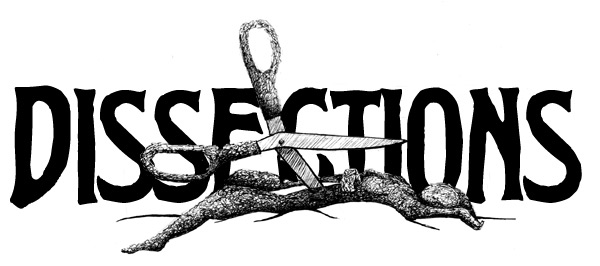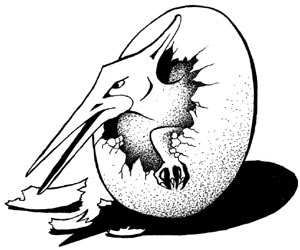[an error occurred while processing this directive]



Writing in a Different Vein: Bob Leman's Clifford M.
Lawrence C. Connolly
Assemble a group of seasoned horror readers, mention Stephanie Meyer’s Twilight, and see how fast the conversation snags on a litany of that author’s deviations from the true vampire archetype. At some point, after a list of transgressions running the gamut from ‘They go out in daylight!’ to ‘They sparkle!’ some devil’s advocate may suggest (as one did at a discussion I attended at the International Conference of the Fantastic in the Arts last March) that perhaps such deviations aren’t bad things. After all, shouldn’t a writer have license to work against archetype when it makes for a good story? I mean, it’s fiction, right?
The liberties that Meyer takes with her vampires have certainly not hurt her sales. This may be because her audience is not made up of seasoned horror readers. By and large, the fans of her series probably don’t care a flying batwing about the vampire archetype. The creatures in Twilight are attractive and darkly alluring, a winning combination for Meyer’s target audience, if not for those who expect vampires to play by the rules.
But the Twilight variations are nothing compared to those played by Bob Leman, a vastly underappreciated writer who 25 years ago gave us a novelette that contains some of the strangest vampires ever pressed between the pages of book or magazine. That story is ‘The Pilgrimage of Clifford M.’
Hardly a household name even among devotees of horror and fantasy, and certainly a virtual unknown to younger readers, Bob Leman began his career with the publication of ‘Bait’ in the January 1967 issue of The Magazine of Fantasy and Science Fiction (F&SF). In his introduction to the story, magazine editor Edward L. Ferman noted that ‘Bait’ featured ‘one of the most ingenious closings’ (p. 95) ever to appear in F&SF. The praise was well founded, and if you have never read the story you owe it to yourself to track it down, since Ferman’s assessment, which was true when F&SF was in its 18th year of publication, remains true today. But if ‘Bait’ marked Leman as a writer to watch, those who started watching for him in 1967 had to wait ten years for his next appearance with a story titled ‘Industrial Complex’ (F&SF, May 1977).Thirteen more stories followed, eleven of them in F&SF, one in Charles L. Grant’s Shadows 10, and another that sold to Harlan Ellison’s still-unpublished Last Dangerous Visions. That last story, ‘How Dobbstown Was Saved’, finally saw publication when Midnight House released Leman’s entire oeuvre in what remains his only extant collection, Feesters in the Lake and Other Stories (2002).
In the discussion that follows, all excerpts from the text of ‘The Pilgrimage of Clifford M.’ will refer to the Midnight House edition, which, as it was prepared by Leman a few years before his death on August 8, 2006, represents the final authoritative versions of his stories.
Written in the voice of a modern American biologist who wishes to revise his technical study of a real life vampire in ‘language less technical than that of the original’ (p.79), ‘Pilgrimage’ makes it clear from the outset that Leman has no intention of being slave to vampire conventions. Beginning his narrative in a detached, clinical style, the narrator first acknowledged and then dashes our preconceptions.
‘There is a widespread belief that vampires create others of their kind by forcing a human being to ingest vampire blood […]. Such a belief is sheer superstition. Those who die of a vampire’s depredations are permanently dead, and, in any case, vampires are mammals – of sort – and they are born as other mammals are born. With, of course, certain differences’ (p. 79).
Those differences, surveyed in the novelette’s opening pages, include females with ten breasts, litters with eight to twelve offspring, and gestation periods of ten years. Born and nursed in caves and abandoned buildings, the young vampires mature slowly, beginning life as toothed tadpoles before growing into hairy, rodent-size children.
The first 1,000 words of the story present a catalogue of such details, as Leman deftly follows one mold-breaking characteristic with another. Then, with the qualities of his new vampire species fully delineated, he begins his story with a 19th century hunter discovering a brood of vampire ‘pups’ (p. 79) in an Appalachian cave. He sees them, flees for his life, and then looks back to make a startling discovery.
‘One of the creatures had locked its teeth in the heel of his boot, and was futilely trying to suck nourishment from the hard leather. It had curled into a ball in the bright sunlight, and its eyes were squeezed shut, but its teeth remained fixed. The thing was about two feet long; it was entirely covered with hair and had four spidery limbs, two of them obviously arms’ (p. 83).
The hunter takes the creature home and places it in a cage, where it is able to observe humans and perhaps on a subconscious level (for the creature’s still-developing mind is yet unable to form clear memories) identify with them. The unclear memories of this captivity will haunt the creature later in life, after he sheds his fur and is able to pass for human. Indeed, the fully clothed adult vampire, or Clifford M. as he comes to be called, almost resembles the vampire of Stoker’s novel: ‘suave, diplomatic, and persuasive’ (p. 93). Yet he is haunted by doubts and desires that lead him on a search through the Appalachian hills for others of his kind – backwoods creatures that prove to be some of the most unsettling vampires ever depicted. In ‘Pilgrimage’, as in all 15 of his stories, Leman gives us creatures that are uniquely his own.
Consider, for example, the following:
‘The young are very tiny at birth, weighing, as a rule, no more than half a pound, and they bear little resemblance to the adult creatures. They resemble, as a matter of fact, tadpoles with rudimentary limbs, or perhaps fetuses. (There is a theory, with a certain amount of evidence to sustain it, that the remote ancestors of vampires were marsupials.)’ (p. 80)
Or this description from an encounter with a pack of adult vampires:
‘They were dirty, indescribably dirty, caked with the filth of decades, the ragged rustic clothing stiff with a thousand drooled spillages of blood, the pale skin ingrained with dirt, the hair and clothing spread with crumbs of earth and clots of mud. The thick, horny nails of their hands were long and black.’ (p. 85)
The originality does not result from ignorance or a lack of familiarity with the tropes of horror, fantasy, and science fiction. Indeed, as a member of science fiction’s First Fandom, Leman distinguished himself early on as a well-informed genre reader. His first writings were published in the letter columns of the early pulps. After that, he edited the well-respected fanzine The Vinegar Worm. There can be no doubt that he knew the works of those writers who went before him, but he seemed determined to cultivate different ground. As his daughter Nancy reports in the review section for Feesters in the Lake at Amazon.com, Leman always felt – in spite of his modest output – ‘that he had written “every story that was in him.”’ Perhaps that’s why his stories are so unique. He only wrote when he had something new to offer, and perhaps the modest output that resulted from such an approach is why he remains relatively unknown today.
Or perhaps it is something else.
In a world where older readers feel more comfortable with the familiar tropes, and where younger readers prefer their vampires to be darkly romantic, perhaps ‘Pilgrimage’ – as well as all of Leman’s stories – is destined to be appreciated only by those willing to embrace the pleasure of the truly strange.
(Larry Connolly reading ‘Shooting Evil’: http://lawrencecconnolly.com/Shooting_Evil.mp3)